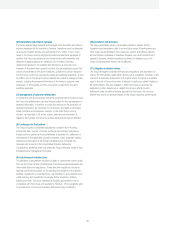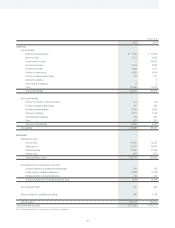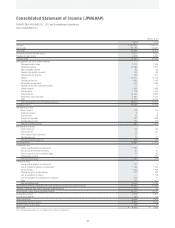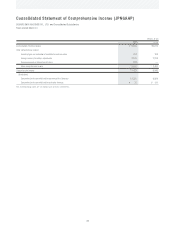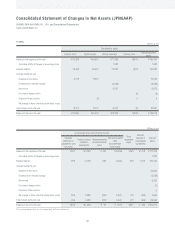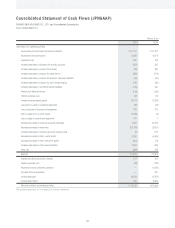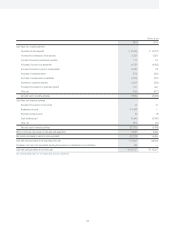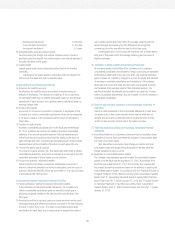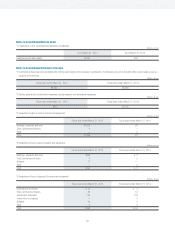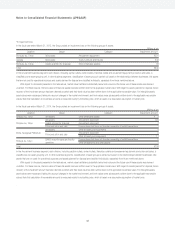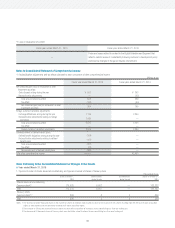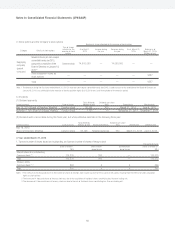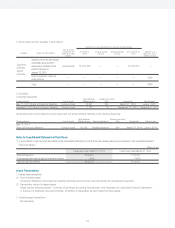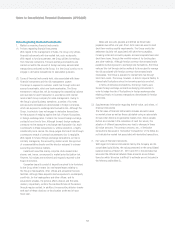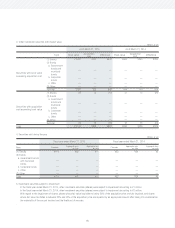Square Enix 2015 Annual Report Download - page 47
Download and view the complete annual report
Please find page 47 of the 2015 Square Enix annual report below. You can navigate through the pages in the report by either clicking on the pages listed below, or by using the keyword search tool below to find specific information within the annual report.
45
Buildings and structures 3–65 years
Tools, furniture and fi xtures 2–20 years
Amusement equipment 3–5 years
B) Intangible assets (excluding leased assets)
Amortized using the straight-line method. Software used in-house is
amortized using the straight-line method based on an internal estimate of
its useful life (three to fi ve years).
C) Leased assets
Leased assets under fi nance lease transactions that do not transfer
ownership.
Depreciation for leased assets is computed under the straight-line
method over the lease term with no residual value.
(3) Accounting for allowances and provisions:
A) Allowance for doubtful accounts
An allowance for doubtful accounts provides for possible losses on
defaults of receivables. The allowance is made up of two components:
the estimated credit loss on doubtful receivables based on an individual
assessment of each account, and a general reserve calculated based on
historical default rates.
B) Provision for bonuses
A provision for bonuses is provided for payments to employees of the
Company and certain consolidated subsidiaries at the amount expected
to be paid in respect of the calculation period ended on the balance
sheet date.
C) Provision for sales returns
At certain consolidated subsidiaries prior to the fi scal year ended March
31, 2015, provisions are provided for losses on the return of published
materials, at an amount calculated based on historical experience prior
to this fi scal year and provisions are provided for losses on the return of
game software and other, comprising an estimated amount of future losses
assessed based on the probability of the return by each game title, etc.
D) Provision for game arcade closings
For closures of game arcades, etc., that have been determined at certain
consolidated subsidiaries, a provision is provided at an amount in line with
reasonable estimates of future losses on such closures.
E) Provision for directors’ retirement benefi ts
At the Company and certain consolidated subsidiaries a provision for
directors’ retirement benefi ts is provided to adequately cover the costs of
directors’ retirement benefi ts, which are accounted for on an accrual basis
in accordance with internal policy.
(4) Accounting treatment methods for retirement benefi ts:
1) Periodic attribution method for projected retirement benefi ts
In the calculation of retirement benefi t obligations, the Company and
certain consolidated subsidiaries apply the benefi t formula basis in
attributing projected benefi ts to the service period until the end of the
fi scal year.
2) Amortization method of actuarial gains and losses and prior service costs
Unrecognized actuarial differences are fully amortized in the year following
the year in which they occur. At certain consolidated subsidiaries,
amortization for each fi scal year is made using the straight-line method
over a certain period (fi ve years) within the average remaining service
period of eligible employees when the differences are recognized,
commencing from the year after the year in which they occur.
Unrecognized prior service costs are amortized over a certain period
(one year or fi ve years) within the average remaining service period of
eligible employees.
(5) Translation of foreign currency transactions and accounts:
All monetary assets and liabilities of the Company and its overseas
consolidated subsidiaries denominated in foreign currencies are translated
at the balance sheet date at the year-end rates. The resulting translation
gains or losses are credited or charged to income. All assets and liabilities
of overseas consolidated subsidiaries are translated as of the balance
sheet date at the year-end rates, and all income and expense accounts
are translated at the average rates for their respective periods. The
resulting translation adjustments are recorded in net assets as “Foreign
currency translation adjustments” and are included in minority interests in
consolidated subsidiaries.
(6) Scope of cash and cash equivalents in the consolidated statements of
cash fl ows:
Cash and cash equivalents in the consolidated statements of cash fl ows
comprises cash on hand, bank deposits which may be withdrawn on
demand and short-term investments with an original maturity of three
months or less and with minimal risk of fl uctuations in value.
(7) Additional accounting policies used to prepare consolidated fi nancial
statements:
A) Accounting treatment of consumption taxes and local consumption taxes
Statement of income items are presented exclusive of consumption taxes
and local consumption taxes.
Non-deductible consumption taxes charged on assets and local
consumption taxes are recognized as expenses for the year when the
related transactions have occurred.
B) Application of consolidated taxation system
The Company has requested approval to apply the consolidated taxation
system from the fi scal year ending March 31, 2016. Accordingly, from
the fi scal year ended March 31, 2015, the Company has implemented
the relevant accounting procedures based on the premise of applying the
consolidated taxation system, in accordance with the “Practical Solution on
Tentative Treatment of Tax Effect Accounting Under Consolidated Taxation
System (Part 1)” (Accounting Standards Board of Japan [ASBJ] Practical
Issues Task Force No. 5, issued January 16, 2015) and “Practical Solution
on Tentative Treatment of Tax Effect Accounting Under Consolidated
Taxation System (Part 2)” (ASBJ Practical Issues Task Force No. 7, issued
January 16, 2015).


